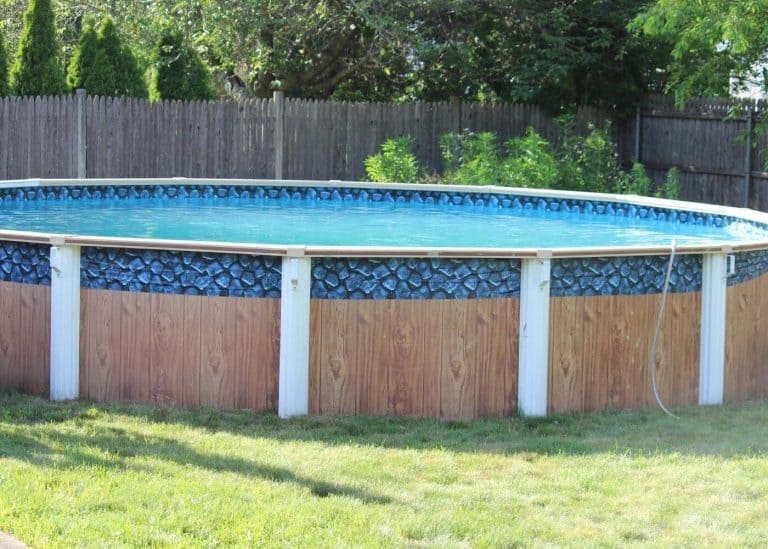We are reader supported, and may earn commissions from links on this page.
If you haven’t tested the waters in a while. Then high acidity could be making the water unsafe for use. This is why so many people need to know how to raise alkalinity in a pool.
Even the pool itself is in danger of corrosion, so it is a skill you will want to learn fast.
Why Raising Alkalinity In A Pool Is Important?

Optimal pH levels in a pool are between 7.2 and 7.8. These are what makes the water suitable for swimming and when the acidity is too high, it can cause real problems.
The corrosive water can play havoc with the pool’s lining and any surface. They can crack, lose their color, and become delaminated.
This leaves a pool looking older than it is, and will sometimes require costly repairs. As soon as you see signs of staining on the walls, you will want to know how to raise alkalinity in a pool.
On top of this, swimmers will suffer from eye irritation and itchy skin.
What Tools And Chemicals Do You Need To Raise Alkalinity In A Pool?
The following is a list of essentials for raising alkalinity in a pool.
Testing Kit
A kit for testing the pH balance of a pool is vital. This is what you need to determine the type of chemicals, as well as the amount.
Alkalinity Increaser
An alkalinity increase keeps the pool water pH levels stable. It helps to prevent damage to the lining, corrosion and keeps total alkalinity at an optimal 80 – 120ppm.
Another option to protect pool equipment and make water safe helps to keep pool water clean and safe.
Sodium Carbonate
Sodium Carbonate is a popular chemical used to raise alkalinity so it is always good to have around.
It is a bit of an all-rounder as it can help to remove stains from the walls, as well as remove grease stains from fabrics.
Another sodium bicarbonate option, this one helps make controlling pH levels easier and is fine for general use.
How To Raise Pool Alkalinity - Best Methods
Here is the process:
- The first thing to do is always test the pH levels. Anything less than 80ppm means that the alkalinity is low.
- Now you need to know how much sodium bicarbonate to raise alkalinity in a pool, and if the level is particularly low, purchase a large container. Read the instructions on the label to determine how much to add.
- If necessary – dilute the formula.
- Add to the pool, but make sure it isn’t windy. Because most sodium bicarbonate comes in a powder form, this can get messy and your pool won’t have the required amount if the wind is blowing it away from the pool.
How To Prevent Low Alkalinity In A Pool?
Regular testing is key to maintaining optimal pH levels in a pool. If the pool is looking murky or
you notice your skin is itchy after entering the pool.
A lot of the time, low alkalinity isn’t noticeable but if the pool lining is looking worse for wear, then it can be a good time to intervene.
Use a pH water test kit twice a week and you should always have hygienic water.
How To Raise Alkalinity In a Pool Without Raising pH?
A process called aeration is used to keep the pH levels as they are but raise alkalinity. This is where you circulate air in the pool when you raise total alkalinity.
Another movement is also required to push the air around. Switch on the pool motor or use different water features like a waterfall. Even inserting an air pump into the pool will add air to the water and help.
Of course, this is far more strenuous, but it does show what is possible.
How To Raise Pool Alkalinity Naturally?
The same method used above is one of the natural ways, but there is another method. Use baking soda as a natural alkalinity increase. It is also known as sodium bicarbonate so any form is going to be fine.
It has a pH level of 8 and will raise the pH and alkalinity of pool water. This improves clarity, retains an optimal balance, and is the active ingredient in many pool products known as alkalinity increaser.
Conclusion
Whilst pool care can seem like a daunting task, regular maintenance becomes easy and is key to optimal chemical balance.
Now you know how to raise alkalinity in a pool, you can take better care of the people using it, and avoid costly repair bills.
Related Pool Reviews:
Beat the summer heat and keep cool
There’s an above ground pool set to suit your budget and the size of your yard.
Let us help you find the best pool for you!





